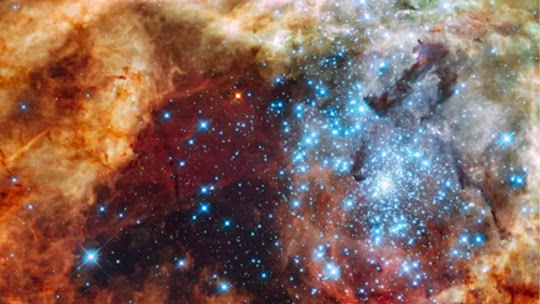Revealing Cosmic Treasures: Hubble's Unveiling of 500 Stellar Easter Eggs
Hubble Space Telescope finds bucket of cosmic Easter eggs — 500 blue and red stars
A Hubble image image of the star forming region 30 Doradus, the Tarantula Nebula, within the Large Magellanic Cloud packed with young bright blue stars (Image credit: NASA, ESA, STScI, Francesco Paresce (INAF-IASF Bologna), Robert O'Connell (UVA), SOC-WFC3, ESO)
Embarking on a Cosmic Odyssey: The ULLYSES Program
In December 2023, the Hubble Space Telescope concluded its monumental Ultraviolet Legacy Library of Young Stars as Essential Standards (ULLYSES) program, marking the culmination of its most extensive operation since its launch in 1990. This ambitious endeavor involved observing 500 individual stars over a span of three years, providing scientists with a wealth of data to unravel the mysteries of the cosmos.
A Treasure Trove of Stellar Insights
The ULLYSES program represents a significant milestone in astrophysics, offering researchers an unprecedented opportunity to delve into various aspects of star formation, evolution, and their impact on the universe. Julia Roman-Duval, the leader of the ULLYSES Implementation Team at the Space Telescope Science Institute, anticipates that this initiative will have a transformative effect on astrophysical research, spanning from exoplanets to the earliest stages of cosmic evolution.
Unraveling the Mysteries of Massive Stars
One of the primary focuses of the ULLYSES program is the study of massive blue stars, which emit intense ultraviolet light and play a crucial role in the dispersion of heavy elements throughout the cosmos. By analyzing the spectra of these stars, scientists aim to gain insights into the dynamics of stellar winds and their contribution to the formation of subsequent generations of stars and planets.
These superhot and massive blue stars, often referred to as "cosmic powerhouses," exhibit extraordinary characteristics that distinguish them from their counterparts. They burn through their nuclear fuel at an accelerated rate, leading to short lifespans but significant impacts on their surroundings. Through the examination of their spectra, researchers hope to uncover clues about the mechanisms driving their stellar winds and the subsequent distribution of elements essential for the formation of celestial bodies.
Peering into the Past: Exploring Metal-Poor Stars
ULLYSES also targets metal-poor stars in galaxies near the Milky Way, serving as proxies for the earliest stars that populated the infant universe. These ancient stars, characterized by their low metallicity, offer invaluable insights into the conditions prevalent during the universe's formative stages. By studying their properties and evolutionary paths, scientists seek to unravel the cosmic narrative of star formation and galactic evolution over billions of years.
The study of metal-poor stars holds profound implications for our understanding of the universe's early epochs and the processes that shaped the celestial landscape we observe today. Through meticulous observations and data analysis, researchers endeavor to reconstruct the intricate tapestry of cosmic evolution, from the primordial gas clouds to the emergence of complex stellar systems.
Shedding Light on Young Red Stars
In addition to massive blue stars, ULLYSES examines young red stars in the Milky Way's star-forming regions, shedding light on the processes of mass accretion and planetary formation. These fledgling stars, characterized by their cooler temperatures and reddish hues, represent the building blocks of planetary systems and potential habitats for extraterrestrial life.
During their formative years, young red stars undergo dynamic processes that shape their environments and influence the formation of planetary disks. By studying the interactions between these stars and their circumstellar material, scientists aim to elucidate the mechanisms driving planet formation and the conditions conducive to habitability within stellar systems.
A Collaborative Endeavor
The success of the ULLYSES program is attributed not only to the capabilities of the Hubble Space Telescope but also to the collaboration with other ground- and space-based observatories. This coordinated effort has enriched the dataset and enabled astronomers to paint a more comprehensive picture of stellar phenomena and their environmental impact.
By leveraging the collective capabilities of multiple observatories, researchers can harness a diverse array of observational techniques and instruments to explore the cosmos with unprecedented depth and clarity. This collaborative approach fosters interdisciplinary research and facilitates the integration of data from various sources, thereby maximizing the scientific yield of astronomical observations.
Implications and Future Directions
The completion of the ULLYSES program heralds a new era of discovery in astrophysics, promising to yield insights into fundamental questions about the origin and evolution of stars and galaxies. As scientists delve deeper into the trove of data collected by Hubble, they anticipate uncovering novel findings that could reshape our understanding of the universe.
The wealth of information amassed through the ULLYSES program will serve as a cornerstone for future research endeavors, providing a comprehensive foundation for exploring diverse areas of astrophysics. From the dynamics of stellar winds to the formation of planetary systems, each facet of the cosmic tapestry offers tantalizing opportunities for further investigation and discovery.
Conclusion: Hubble's Enduring Legacy
The ULLYSES program exemplifies Hubble's enduring legacy as a pioneering instrument for astronomical research. Despite over three decades of operation, Hubble continues to push the boundaries of scientific exploration, reaffirming its status as one of humanity's most invaluable tools for unraveling the mysteries of the cosmos. As we stand on the threshold of a new era of discovery, fueled by the insights gleaned from programs like ULLYSES, we embark on a journey of exploration and understanding, guided by the light of distant stars and the boundless curiosity of the human spirit.
Disclaimer:
The following article is a summary crafted based on publicly available information and does not represent original reporting. The content has been synthesized to provide a comprehensive overview of the news article titled "Hubble Space Telescope finds bucket of cosmic Easter eggs — 500 blue and red stars,". While efforts have been made to accurately represent the key points and details of the original article, readers are encouraged to refer to the source material for a more in-depth understanding of the subject matter.
Readers are encouraged to exercise critical thinking and verify information from multiple sources before forming conclusions or making decisions based on the content presented in this summary.
Click here for: [Original News Article]




Comments
Post a Comment